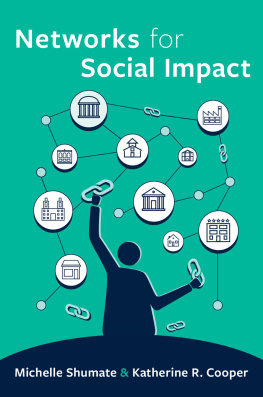Networks for Social Impact

Oxford University Press is a department of the University of Oxford. It furthers the Universitys objective of excellence in research, scholarship, and education by publishing worldwide. Oxford is a registered trade mark of Oxford University Press in the UK and certain other countries.
Published in the United States of America by Oxford University Press
198 Madison Avenue, New York, NY 10016, United States of America.
Oxford University Press 2022
All rights reserved. No part of this publication may be reproduced, stored in a retrieval system, or transmitted, in any form or by any means, without the prior permission in writing of Oxford University Press, or as expressly permitted by law, by license, or under terms agreed with the appropriate reproduction rights organization. Inquiries concerning reproduction outside the scope of the above should be sent to the Rights Department, Oxford University Press, at the address above.
You must not circulate this work in any other form and you must impose this same condition on any acquirer.
CIP data is on file at the Library of Congress
Names: Shumate, Michelle, author. | Cooper, Katherine R., author.
Title: Networks for social impact / Michelle Shumate, Katherine R. Cooper.
Description: New York : Oxford University Press, 2022. |
Includes bibliographical references and index.
Identifiers: LCCN 2021015835 (print) | LCCN 2021015836 (ebook) |
ISBN 9780190092009 (paperback) | ISBN 9780190091996 (hardback) |
ISBN 9780190092023 (epub)
Subjects: LCSH: Business networksManagement. | Organizational behavior. |
Social networks. | Social change.
Classification: LCC HD69.S8 S548 2021 (print) | LCC HD69.S8 (ebook) |
DDC 658.4/08dc23
LC record available at https://lccn.loc.gov/2021015835
LC ebook record available at https://lccn.loc.gov/2021015836
DOI: 10.1093/oso/9780190091996.001.0001
MS: For my parents, who showed me that a life of service is the highest calling
KRC: For Belle and Charlotte, the next generation of impact-makers
Contents
Michelle Shumate and Kate Cooper have written a book the network field badly needs. Networks are often portrayed as solutions to problems of collaboration as if the absence of collaboration is the problem, and not the social problem that compels collaboration in the first place. Shumate and Cooper call our attention to the social impact of the collaborative activity. Their view is that networks of various forms and types allow us to both solve collective action problems and allow us to have a social impact on wicked problems like homelessness, mental health, and natural disasters. That is the theme of this book. Shumate and Cooper use their own research, case studies, and an exhaustive review of the research on networks to answer that question. The answer does not lie in choosing a template or a set of best practices that apply to any network or any problem; rather they define the kind of networks that can achieve social impact and several pathways these networks use to produce a social impact based on the nature of the social problem or issue, the goals of the network, and the networks environment.
The goals of this book are to bring together siloed scholarship on networks from both social science and management, breaking it into configurational and process approaches. More importantly, the book engages students and network leaders in an accessible manner that retains fidelity to the research. To my mind, this is what the field of collaborative networks needs badly. There are plenty of self-proclaimed network gurus or consulting firms selling commercial products that claim to have the solution to the collaborative dilemma based on their experience or one or two examples. There is work that seriously reviews the research literature and distills the practice implications from it. What we have not had until now is work that seriously reviews the research literature, classifies it, separates out what is germane for social impact, and gives readers the tools to build networks and evaluate them, both in the service of social impact in our communities. Shumate and Cooper present the reader with five axioms of networks for social impact.
Outcomes are interdependent.
Networks for social impact are sensitive to their environment.
Networks dilemmas are never solved, just managed within constraints.
Not all networks organized for social impact actually achieve that impact.
There is more than one path to social impact.
These axioms serve as the organizing framework for the book as the authors explore the subtle ways these axioms play out in specific examples. Not all networks organized for social impact actually achieve that impact (axiom 4) calls our attention to failure as well as success. We can learn a great deal from networks that fail to achieve their goals so we can avoid these problems in the future. Networks that arent successful may fail in multiple ways that are very helpful to network architects. Several years ago, I evaluated two Collective Impact networks that were viewed as successes. United Way had originally funded four and I asked what happened to the other two. They failed. How did they fail? I asked. It doesnt matter, was the reply. It matters greatly, because how can we avoid pitfalls and problems if we only have a theory of success?
Network architects need failures and successes to construct networks that are recursive and path-dependent. These qualities present themselves to network leaders as managerial dilemmas. Dilemmas that represent opposing values can never be solved, only balanced better or worse. The trade-off that the network leader makes at one time may cause a problem with the other value somewhere down the road. Too much integration of the network at one point may create tensions that lead to calls for differentiation at another point, thus a temporary equilibrium is the most a network leader can hope for.
It is obvious that I like this book a lot. It is smart, nuanced, well-written and faithful to the research. All that is true, but what I like most about it is that it treats the reader as a partner in the enterprise of building networks for social impact. Shumate and Cooper say, Here are your tools, lets get going, this is going to be fun.
H. Brinton Milward
Melody S. Robidoux Foundation Fund Chair in Collaborative Governance, University of Arizona
J. K. Popp et al., Interorganizational Networks, Collaboration across Boundaries Series (Washington, DC: IBM Center for the Business of Government, 2014) .
In 2012, when Kate began to write her dissertation on Community Reach, we started a journey together to understand the collective impact movement. Michelle had been researching networks of nonprofits for about a decade. Still, there was something new and exciting about the idea of organizations working together across sectors to impact their communities. Since then, we have been privileged to work with and study many networks for social impact. Some of these networks got their start as part of the collective impact movement; others had been around for decades. Many networks do not adhere to the collective impact model or consider themselves part of it at all.
Eric Nee, the editor-in-chief of Stanford Social Innovation Review, when describing our research developing the Community Systems Solution Framework, wrote that we need a repertoire of approaches that can be adopted when appropriate. In many ways, his call sums up the reason why we wrote this book. Collective impact, or any of the models in the Community Systems Solutions Framework, for that matter, is not a one-size-fits-all solution. Instead, as we argue in this volume, there are many pathways to social impact. The critical factors that determine whether networks will make a social impact are making the right choices for the context and managing network dilemmas that never go away.







![switching.social [switching.social] - The Switching Social Handbook](/uploads/posts/book/131346/thumbs/switching-social-switching-social-the-switching.jpg)



